
by SpaceJace | Jul 1, 2013 | News
The Everyday Space Traveler honored with “Book of the Year” Award
The Everyday Space Traveler was recently honored with a Book of the Year Award from Foreword Reviews. That makes 3 awards this year.

Nautilus “GRAND PRIZE” Book Award
The Everyday Space Traveler also won the Nautilus Grand Prize for Young Adult Non-Fiction and was voted one of three “Best-In-Show”. We are honored to be among the winners of Nautilus’ Better Books for a Better World. Nautilusbookawards.com

Benjamin Franklin Award
The Everyday Space Traveler was also awarded the Silver Medal in the Benjamin Franklin Awards from the Independent Book Publisher’s Association. Named in honor of America’s most cherished publisher/printer, the Benjamin Franklin Award™ recognizes excellence in independent publishing. We congratulate Gold Medal Winner Jean-Michel Cousteau and Ocean Publishing.

by SpaceJace | Jun 4, 2013 | News
The EVERYDAY SPACE TRAVELER
Wins a Nautilus “GRAND PRIZE” Book Award
“The Everyday Space Traveler” won the Nautilus Grand Prize for Young Adult Non-Fiction. Written by Jason Klassi with a foreword by Apollo 11 moonwalker Buzz Aldrin, the book was voted one of three “Best-In-Show”.

Book of the Year Award
The Everyday Space Traveler is also a finalist for the Book of the Year Award from Foreword Reviews in three categories: Science, Adventure Travel and Young Adult Nonfiction.

Benjamin Franklin Award
“The Everyday Space Traveler” was also awarded the Silver Medal in the Benjamin Franklin Awards from the Independent Book Publisher’s Association. Named in honor of America’s most cherished publisher/printer, the Benjamin Franklin Award™ recognizes excellence in independent publishing. We congratulate Gold Medal Winner Jean-Michel Cousteau and Ocean Publishing.
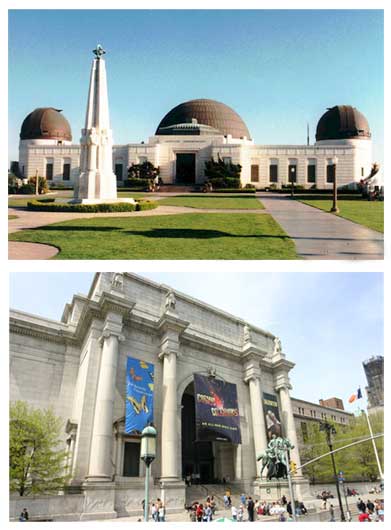
by SpaceJace | Nov 24, 2012 | News
The Everyday Space Traveler, with foreword by Apollo 11 astronaut Buzz Aldrin, is now available at the Griffith Observatory in Los Angeles and the American Museum of Natural History in New York.
Buzz Aldrin says “The Everyday Space Traveler is the first book that brings pace travel down to Earth and makes these profound insights available to us all.”
John Spencer, founder of the Space Tourism Society says “[Jason] truly hits a cord with people getting deep down into the “why” we explore and “what” does it mean to be an explorer. [He] takes us to a higher level and we are all the better for it.”
The Everyday Space Traveler is also available in both hardcover and ebook formats at Amazon.com, BarnesandNoble.com and iTunes. Visit these website to “Look inside” and see some of the book’s spectacular full color images, the beauty of the cosmos and the secrets of the universe inside yourself.
Like the astronauts, you too can discover timeless secrets of the universe that have taken earthbound humans millennia to understand. Join the voyagers of EXPEDiTiON LiFEPOiNT as The Everyday Space Traveler takes you on a virtual voyage to Mars. Experience aspects of space travel right here on Earth and change your life forever.
With so many people wanting to travel in space – to experience its weightlessness and to gaze back at the majesty of our home planet spinning among the stars – space tourism is a real and burgeoning industry.
Passenger spaceships are being built right now by such visionary entrepreneurs as Virgin Airlines’ Richard Branson and Amazon’s Jeff Bezos. More and more people – from celebrities to schoolteachers – are booking a coveted seat for the chance to infuse some cosmic sense into their everyday lives.

The Griffith Observatory in Los Angeles (top) and the American Museum of Natural History in New York (bottom).
Space Travel: It’s not just for astronauts anymore.
Don’t wait to embark on your first space adventure. Experience the cosmos now – using this book as your private spaceship. Strap in, take off and open yourself to an epic journey that will leave you empowered, inspired and forever transformed.
Get ready to discover: 9 profound insights from space travel that will enhance your life on this planet:
- Exhilarating space-travel experiences you can have right here on Earth
- Enlightening tips for better navigating your daily life
- A practical plan for your own real-life space journey
- The awe-inspiring, life-changing visual beauty of space
- and so much more
The Everyday Space Traveler
Discover 9 Life-Affirming Insights into the Wonders of Inner and Outer Space
by Jason Klassi, Foreword by Buzz Aldrin, Apollo 11 moonwalker
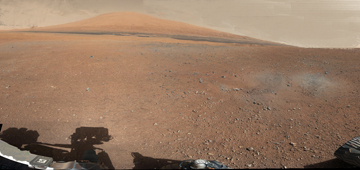
by SpaceJace | Oct 12, 2012 | News
A rock on Mars, discovered by NASA’s Curiosity rover, is surprisingly similar to a well-known kind of rock on Earth.
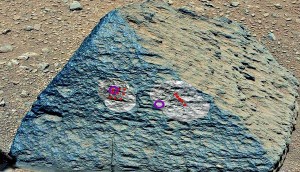
Earth-like Rock discovered on Mars (credit: NASA/JPL)
This type of rock is the first of its kind encountered on Mars. The 16-inch-tall pyramid-shape rock is named “Jake Matijevic” in honor of a Curiosity mission team member who died in August. Curiosity encountered “Jake” at its landing spot in Mars’ Gale Crater.
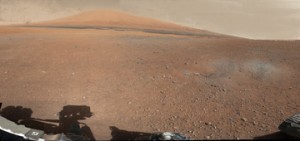
View of Mount Sharp from the Mars Rover "Curiosity" (Credit: NASA/JPL)
Curiosity was launched November 26, 2011, at 10:02 EST and landed on Mars at Gale Crater close to midnight on August 5, 2012. Curiosity used a much more precise landing system than previously attempted. Thanks to the people at NASA and JPF, Curiosity is now going about it’s business assessing the habitability of the Red Planet.
A primary mission objective is to determine whether Mars is or has ever been able to support life. Curiosity can chemically analyze samples by scooping up soil, drilling rocks, and using a laser sensor system.
Other goals of this mission are to collect data for a human mission, study Martian geology and study the climate. The discoveries on Mars may help us address climate change issues on Earth.
The Curiosity rover is about five times larger than the Spirit or Opportuity Mars Exploration Rovers and carries more than ten times the mass of scientific instruments. Curiosity will explore for at least 687 Earth days (1 Martian year) over a range of 5–20 km (3–12 miles).
The Mars Science Laboratory mission is part of NASA’s Mars Exploration Program, a long-term effort of robotic exploration of Mars. The project is managed by the Jet Propulsion Laboratory of the California Institute of Technology for NASA. The total cost of the MSL project is about US $2.5 billion.
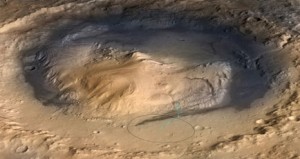
Curiosity was launched November 26, 2011, at 10:02 EST and landed on Mars at Gale Crater, near Mount Sharp on August 6, 2012. Image Credit: NASA/JPL-Cal Tech
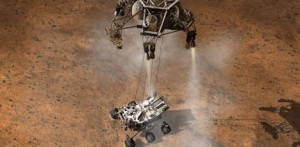
Entry, descent, and landing for the Mars Science Laboratory missionwill use a guided entry and a sky crane touchdown system to land the hyper-capable, massive rover.Image credit: NASA/JPL-Caltech
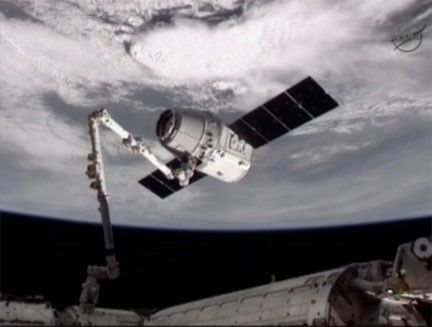
by SpaceJace | May 27, 2012 | News
In a symbolic and historic “handshake”, the astronauts inside the International Space Station reached out with their robotic arm and grabbed the Dragon by the tail. On Friday the first private spacecraft docked with the remote outpost orbiting 200 miles above our heads.
It was more than just supplies the Dragon delivered, but the promise of a carrying crewmembers. Since the retirement of the Space Shuttle, the only other way to orbit is aboard a Russian Soyuz spacecraft
This adventurous and historical feat may create a powerful alliance that re-enables NASA to put more focus on the science of space travel and sending humans to Mars. In addition, the prospects for free enterprise in space are boundless.
Congratulations to Elon Musk and everyone at SpaceX, NASA and the astronauts aboard ISS. This is a great day for people on Earth and another step into a new frontier for all humanity. The civilization we ultimately create in space and the worlds we will visit may well be beyond our wildest imagination.
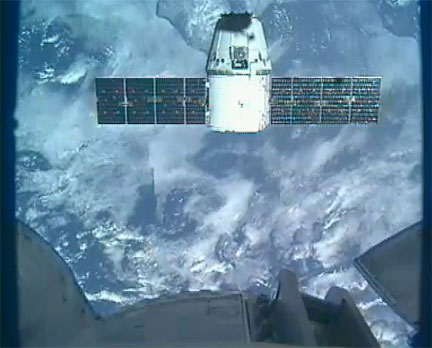
SpaceX's Dragon spacecraft about 30 meters from the station. Photo: NASA

SpaceX Dragon docks with the International Space Station — the first private spacecraft ever to do so. (Credit: NASA)
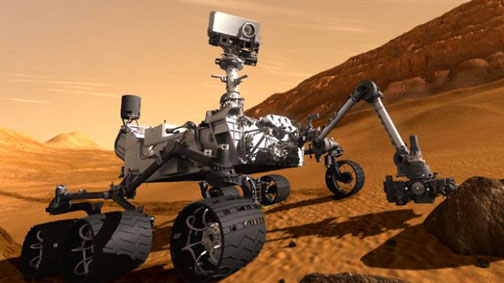
by SpaceJace | Apr 26, 2012 | News
Once again, humans will soon vicariously land on Mars and explore her mysteries through the virtual eyes of Curiosity – NASA’S latest rover on the Red Planet.
Currently in transit to Mars, Curiosity was launched November 26, 2011, at 10:02 EST and is scheduled to land on Mars at Gale Crater, near Mount Sharp on August 6, 2012. Curiosity will try a more precise landing than previously attempted. If the landing is successful, Curiosity will then go about it’s business assessing the habitability of the Red Planet.
A primary mission objective is to determine whether Mars is or has ever been able to support life. Curiosity can chemically analyze samples by scooping up soil, drilling rocks, and using a laser sensor system.
Other goals of this mission are to collect data for a human mission, study Martian geology and study the climate. The discoveries on Mars may help us address climate change issues on Earth.
The Curiosity rover is about five times larger than the Spirit or Opportuity Mars Exploration Rovers and carries more than ten times the mass of scientific instruments. Curiosity will explore for at least 687 Earth days (1 Martian year) over a range of 5–20 km (3–12 miles).
The Mars Science Laboratory mission is part of NASA’s Mars Exploration Program, a long-term effort of robotic exploration of Mars. The project is managed by the Jet Propulsion Laboratory of the California Institute of Technology for NASA. The total cost of the MSL project is about US $2.5 billion.

Currently in transit to Mars, Curiosity was launched November 26, 2011, at 10:02 EST and is scheduled to land on Mars at Gale Crater, near Mount Sharp on August 6, 2012. Image Credit: NASA/JPL-Cal Tech

Entry, descent, and landing for the Mars Science Laboratory missionwill use a guided entry and a sky crane touchdown system to land the hyper-capable, massive rover.Image credit: NASA/JPL-Caltech













